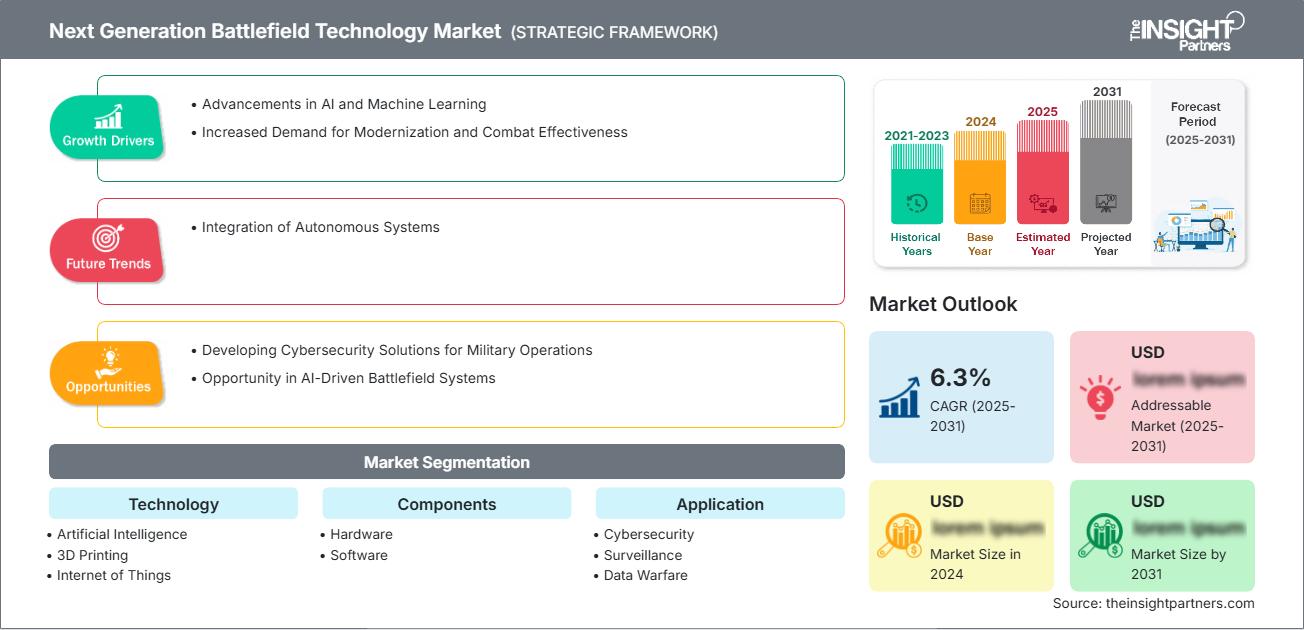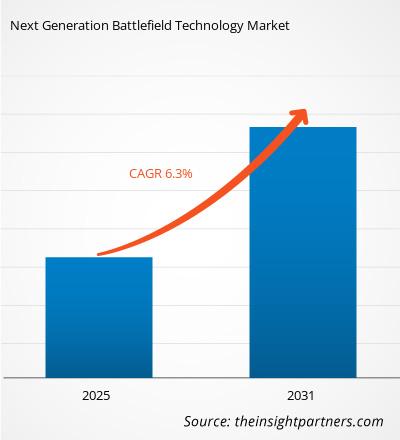The Next Generation Battlefield Technology Market is expected to register a CAGR of 6.3% from 2025 to 2031, with a market size expanding from US$ XX million in 2024 to US$ XX Million by 2031.
The report is segmented by Technology (Artificial Intelligence, 3D Printing, Internet of Things, Wearable Devices); Components (Hardware, Software); Application (Cybersecurity, Surveillance, Data Warfare, Logistics and Transportation, Explosive Ordinance Disposal (EOD), Health Monitoring, Combat Simulation and Training, Others). The global analysis is further broken-down at regional level and major countries. The Report Offers the Value in USD for the above analysis and segments.
Purpose of the Report
The report Next Generation Battlefield Technology Market by The Insight Partners aims to describe the present landscape and future growth, top driving factors, challenges, and opportunities. This will provide insights to various business stakeholders, such as:
- Technology Providers/Manufacturers: To understand the evolving market dynamics and know the potential growth opportunities, enabling them to make informed strategic decisions.
- Investors: To conduct a comprehensive trend analysis regarding the market growth rate, market financial projections, and opportunities that exist across the value chain.
- Regulatory bodies: To regulate policies and police activities in the market with the aim of minimizing abuse, preserving investor trust and confidence, and upholding the integrity and stability of the market.
Next Generation Battlefield Technology Market Segmentation
Technology
- Artificial Intelligence
- 3D Printing
- Internet of Things
- Wearable Devices
Components
- Hardware
- Software
Application
- Cybersecurity
- Surveillance
- Data Warfare
- Logistics and Transportation
- Explosive Ordinance Disposal
- Health Monitoring
- Combat Simulation and Training
- Others
Geography
- North America
- Europe
- Asia-Pacific
- South and Central America
- Middle East and Africa
You will get customization on any report - free of charge - including parts of this report, or country-level analysis, Excel Data pack, as well as avail great offers and discounts for start-ups & universities
Next Generation Battlefield Technology Market: Strategic Insights

-
Get Top Key Market Trends of this report.This FREE sample will include data analysis, ranging from market trends to estimates and forecasts.
Next Generation Battlefield Technology Market Growth Drivers
- Advancements in AI and Machine Learning: The incorporation of AI and Machine Learning (ML) into military technology is transforming battlefield capabilities. AI-powered systems improve decision-making, allow for real-time data processing, improve autonomous systems (such as drones and unmanned vehicles), and help predictive maintenance of military equipment. The demand for faster, more precise responses in combat situations is driving the development of next-generation technologies to achieve a tactical advantage on the battlefield.
- Increased Demand for Modernization and Combat Effectiveness: With global defense spending increasing, there is a strong drive to update military equipment and improve combat effectiveness. Countries are investing in cutting-edge combat technologies to improve their operational capabilities. Advanced armament, precision targeting systems, augmented reality (AR) for soldiers, and next-generation communication technologies all provide improved performance and interoperability in complicated and rapidly changing conflict settings.
Next Generation Battlefield Technology Market Future Trends
- Integration of Autonomous Systems: Autonomous technologies, such as drones, autonomous ground vehicles (AGVs), and AI-powered robotics, are increasingly important in modern combat. These systems have advantages such as lowering human losses, performing surveillance, providing logistical support, and carrying out targeted strikes without direct human participation. The current trend is toward totally autonomous operations, which enable faster, safer, and more effective battlefield assistance.
- Augmented Reality (AR) and Virtual Reality (VR) are changing the way armies train and fight. These technologies provide immersive training settings, allowing soldiers to replicate combat scenarios and learn tactics without the dangers of actual battle. AR systems are utilized on the battlefield to provide soldiers with real-time data overlays that assist them in navigating, identifying targets, and making educated decisions, hence improving situational awareness and operational efficiency.
Next Generation Battlefield Technology Market Opportunities
- Developing Cybersecurity Solutions for Military Operations: As the battlefield relies more on digital networks, communication systems, and IoT devices, the necessity for strong cybersecurity solutions grows. This creates a tremendous potential for the development of advanced cybersecurity technology to defend military systems from cyberattacks, electronic warfare, and data breaches.
- Opportunity in AI-Driven Battlefield Systems: The next-generation battlefield technology market presents significant opportunities through the integration of artificial intelligence (AI) and machine learning. These technologies can revolutionize decision-making processes, optimize logistics, and enhance situational awareness. By providing autonomous capabilities for surveillance, threat detection, and combat strategies, AI-driven systems are expected to play a pivotal role in modernizing military operations, creating a strong demand for advanced solutions in the defense sector.
Next Generation Battlefield Technology Market Regional Insights
The regional trends and factors influencing the Next Generation Battlefield Technology Market throughout the forecast period have been thoroughly explained by the analysts at The Insight Partners. This section also discusses Next Generation Battlefield Technology Market segments and geography across North America, Europe, Asia Pacific, Middle East and Africa, and South and Central America.
Next Generation Battlefield Technology Market Report Scope
| Report Attribute | Details |
|---|---|
| Market size in 2024 | US$ XX million |
| Market Size by 2031 | US$ XX Million |
| Global CAGR (2025 - 2031) | 6.3% |
| Historical Data | 2021-2023 |
| Forecast period | 2025-2031 |
| Segments Covered |
By Technology
|
| Regions and Countries Covered |
North America
|
| Market leaders and key company profiles |
|
Next Generation Battlefield Technology Market Players Density: Understanding Its Impact on Business Dynamics
The Next Generation Battlefield Technology Market is growing rapidly, driven by increasing end-user demand due to factors such as evolving consumer preferences, technological advancements, and greater awareness of the product's benefits. As demand rises, businesses are expanding their offerings, innovating to meet consumer needs, and capitalizing on emerging trends, which further fuels market growth.

- Get the Next Generation Battlefield Technology Market top key players overview
Key Selling Points
- Comprehensive Coverage: The report comprehensively covers the analysis of products, services, types, and end users of the Next Generation Battlefield Technology Market, providing a holistic landscape.
- Expert Analysis: The report is compiled based on the in-depth understanding of industry experts and analysts.
- Up-to-date Information: The report assures business relevance due to its coverage of recent information and data trends.
- Customization Options: This report can be customized to cater to specific client requirements and suit the business strategies aptly.
The research report on the Next Generation Battlefield Technology Market can, therefore, help spearhead the trail of decoding and understanding the industry scenario and growth prospects. Although there can be a few valid concerns, the overall benefits of this report tend to outweigh the disadvantages.
Frequently Asked Questions
What are the options available for the customization of this report?
What are the driving factors impacting the next generation battlefield technology market?
1. Advancements in AI and Machine Learning.
2.Increased Demand for Modernization and Combat Effectiveness
What are the future trends of the next generation battlefield technology market?
Which are the key players in the next generation battlefield technology market?
What is the expected CAGR of the next generation battlefield technology market?
- Historical Analysis (2 Years), Base Year, Forecast (7 Years) with CAGR
- PEST and SWOT Analysis
- Market Size Value / Volume - Global, Regional, Country
- Industry and Competitive Landscape
- Excel Dataset
Recent Reports
Testimonials
Reason to Buy
- Informed Decision-Making
- Understanding Market Dynamics
- Competitive Analysis
- Identifying Emerging Markets
- Customer Insights
- Market Forecasts
- Risk Mitigation
- Boosting Operational Efficiency
- Strategic Planning
- Investment Justification
- Tracking Industry Innovations
- Aligning with Regulatory Trends





















 Get Free Sample For
Get Free Sample For